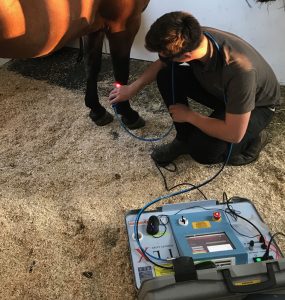Equine Therapy for Kid: Emotional and Behavioral Support Discussed
Equine Therapy for Kid: Emotional and Behavioral Support Discussed
Blog Article
Laser Therapy in Horse Therapy: A Modern Technique to Improving Steed Wellness
Laser therapy has emerged as a crucial technique in equine therapy, making use of concentrated light energy to cultivate mobile repair service and speed up healing from a selection of disorders. By stimulating mitochondrial activity and boosting ATP production, laser therapy not just boosts blood circulation however also offers considerable pain alleviation.
Comprehending Laser Therapy
Laser treatment, a non-invasive treatment modality, has acquired significant traction in equine medicine as a result of its effectiveness in advertising recovery and pain relief. This innovative healing technique makes use of focused light energy to permeate tissues, cultivating cellular repair work and regrowth. The underlying mechanism involves the excitement of cellular mitochondria, leading to increased production of adenosine triphosphate (ATP), the energy money of cells. Enhanced ATP levels expedite tissue repair service processes and reduce swelling, making laser treatment specifically reliable for dealing with bone and joint injuries, injuries, and various other inflammatory problems in steeds.
There are numerous sorts of lasers utilized in equine treatment, each with particular wavelengths and power outcomes tailored to various therapeutic demands. Low-level laser therapy (LLLT), also referred to as cool laser treatment, uses reduced power levels to promote cell feature without creating thermal damages. High-intensity laser therapy (HILT), on the other hand, utilizes higher power levels to achieve deeper tissue infiltration and even more considerable restorative results.
Veterinarians utilize different laser tools and techniques depending upon the problem being dealt with and the desired depth of tissue infiltration. Correct training and knowledge are crucial for making certain the safe and efficient application of laser therapy, therefore optimizing its restorative possibility while lessening risks.
Advantages for Equine Wellness
With a strong understanding of just how laser treatment functions, it is vital to discover its various advantages for equine health. One of the primary benefits is its capacity to accelerate cells repair and cell growth. By promoting cellular function, laser treatment advertises faster injury recovery and aids in the regrowth of broken tissues. This can be specifically helpful in lowering recovery times for equines suffering from injuries.
In addition, laser therapy has actually been revealed to enhance circulation, therefore improving blood flow to impacted locations. Enhanced circulation makes sure that vital nutrients and oxygen are provided a lot more successfully, assisting in the recovery procedure. In addition, laser therapy's anti-inflammatory results assist in decreasing swelling and discomfort, which is important for the overall wellness of the steed.
Discomfort administration is one more substantial advantage. By releasing endorphins and blocking pain signals, laser treatment supplies effective, non-invasive remedy for both intense and persistent pain. This can add to boosted flexibility and quality of life for the pet.
Finally, laser treatment is a non-invasive treatment choice, lessening the threat of issues connected with even more invasive procedures. Its adaptability and efficacy make it an indispensable tool in contemporary horse vet medication.
Usual Conditions Dealt With

An additional widespread problem treated with laser treatment is arthritis. Steeds experiencing both acute and persistent joint inflammation gain from the anti-inflammatory effects of laser therapy, which helps to ease pain and enhance joint function. In addition, laser therapy is utilized in the management of injuries. Whether dealing with medical incisions or traumatic injuries, the modality promotes quicker tissue repair and minimizes the danger of infection.
Equine respiratory system conditions, such as recurring air passage blockage (RAO), likewise react favorably to laser treatment. The anti-inflammatory properties of the therapy help in minimizing air passage inflammation, thus boosting respiratory feature. Additionally, laser therapy is advantageous in dealing with hoof troubles, consisting of laminitis and abscesses. By boosting flow and minimizing pain, it supports quicker healing.
Treatment and Safety And Security
Applying laser treatment in equine therapy entails a meticulous treatment to make certain both effectiveness and safety. Equine Therapy. The procedure begins with a comprehensive veterinary evaluation to determine the viability of laser therapy for the horse's specific condition. As soon as considered suitable, the therapy location is prepared by cleansing and, if needed, clipping the hair to boost laser penetration
The professional needs to select the appropriate kind of laser, generally a low-level laser (LLLT) or a high-power laser (HPL), these details depending upon the condition being treated. The laser tool is after that calibrated to the proper wavelength, power, and duration setups. Throughout the application, the practitioner relocates the laser over the targeted location in a systematic fashion, making sure consistent and even direct exposure.
Safety protocols are strictly followed, including using protective eyewear for both the practitioner and the steed. Additionally, it is essential to check the equine for any indicators of discomfort or unfavorable reactions throughout the treatment. Post-treatment, the equine is commonly given a period of rest to permit the restorative effects to materialize.

Future of Equine Laser Therapy
As developments in vet medication proceed to unravel, the future of equine laser treatment holds substantial pledge. Emerging technologies and deeper scientific understandings are established to refine and expand the applications of laser treatment for equines.
In addition, recurring research into the molecular and mobile systems of laser therapy address will likely produce enhanced procedures tailored to details problems, enhancing performance and decreasing treatment times. Individualized therapy strategies based on hereditary and biochemical pens might become a reality, making certain that each horse receives the most proper and reliable treatment.
Moreover, governing advancements and standardization of methods will certainly improve the trustworthiness and dependability of laser treatment in equine method. Equine Therapy. As these advancements remain to emerge, equine laser treatment is poised to become a crucial component of vet treatment, offering boosted recovery and enhanced lifestyle for equines internationally
Final Thought

Report this page